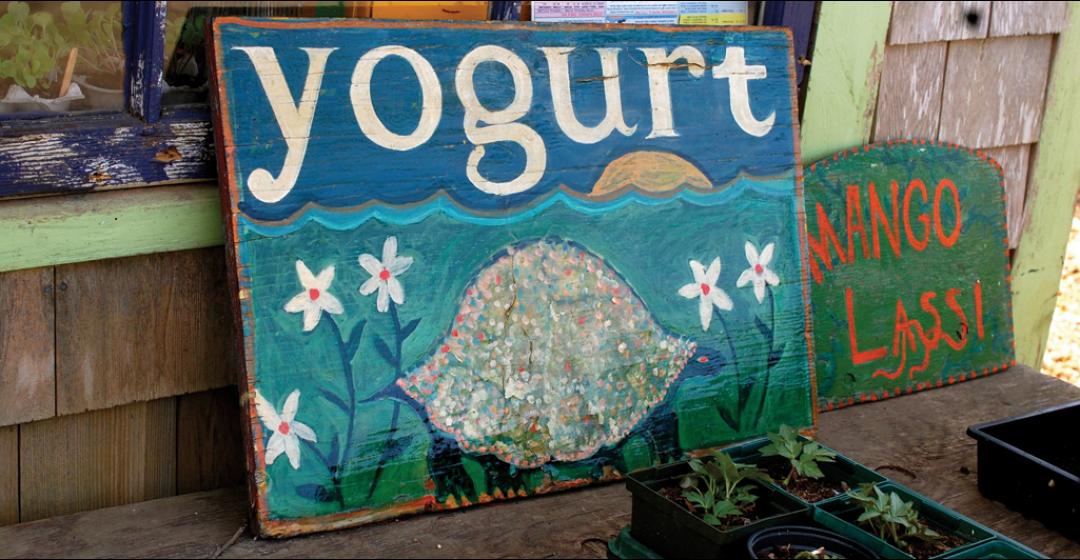Before Ottolenghi, there was Mermaid Farm. That is to say, before London-based, Jerusalem-born best-selling cookbook author and chef Yotam Ottolenghi made yogurt the indispensable cooking ingredient of the decade, Allen Healy and Caitlin Jones were quietly fermenting the milk of their Jersey-Normande cows into some pretty tasty yogurt – right here in Chilmark. Well, maybe not so quietly. Sometimes, in high season, tires screech and horns honk when customers back up at the farm stand, waiting their turn to open the Fridge of Goodies inside the little hut at the entrance to the farm on Middle Road. (People, there is really no need for this. Healy makes 200 quarts of yogurt at a time; the farm stand will be stocked when this issue reaches your hands.)
To be historically accurate, yogurt has been around for millennia. Ancient Greek, Persian, and Indian sources all mention it, whether made from cow’s milk, sheep’s milk, or goat’s milk. In this country, however, yogurt was first produced commercially in 1929 by Armenian immigrants Rose and Sarkis Colombosian (remember Colombo?) in Andover, Massachusetts. How cool is that? What’s global can be local, and what’s old can be new again. So in light of, you know, everything, I’m thinking this is a good year to celebrate how food crosses cultures and continents and brings people together. Let’s celebrate what we have in common, rather than delineate our differences. Yogurt, yes. It gets around.
The real point is this: we may be an Island with great local food, but we are part of a global food culture, too, which we both contribute to and take away from. And in the case of Mermaid Farm yogurt, there is a lovely collision of those two ideas. While the yogurt-making process is ancient – cultures added to milk devour lactose, creating lactic acid that transforms the texture and flavor of milk into yogurt – the milk from Healy’s grass-fed Jersey cows lends a distinct creaminess and Chilmark terroir to the yogurt.
Let’s assume you’ve read up on your beneficial bacteria and all the health benefits of yogurt and go ahead and get into the fun stuff: what to do with that yogurt in the kitchen. For starters, know that yogurt loves being paired with honey, citrus, berries, herbs, cucumbers, cumin, coriander, and leafy greens. Of course you could, and should, look for specific ideas in Ottolenghi’s books. But don’t overlook our local cookbook authors, who have some excellent suggestions.
Chilmark resident Cathy Walthers, author of Kale, Glorious Kale and Raising the Salad Bar, teaches cooking classes with Mermaid Farm yogurt every summer. She is crazy about it. First, she says, don’t think of yogurt as only for breakfast. It’s just as good in appetizers, salads, sauces for vegetables and fish, and even desserts like chocolate yogurt mousse and no-bake blueberry yogurt cheesecake parfaits.
Next, she suggests turning yogurt into a sauce for sautéed greens or roasted vegetables. “Simply add a bit of citrus like lemon juice, a clove of garlic, and either fresh herbs such as mint or coriander or spices like cumin or cardamom. Add a tiny bit of local honey to the sauce, which balances dark leafy greens.” Walthers also likes to use yogurt (with cilantro, lime, and garlic) in a marinade for tandoori grilled chicken since yogurt breaks down proteins and tenderizes the meat. Lastly, she says her favorite use for yogurt is tzatziki, a dip or sauce for pita bread, veggies, or even fish that she makes with cucumber, lemon, mint or cilantro, olive oil, and garlic.
Little Bites author Sarah Waldman of Vineyard Haven uses yogurt to make healthy frozen treats for her kids. “We make homemade frozen yogurt with our very basic ice cream maker (using whatever fruit is ripe at that time, from strawberries to peaches) and we make a wide variety of yogurt-based popsicles, like mango lassi pops and chocolate-banana pops, using the yogurt as a creamy base.” In Little Bites, Waldman also uses yogurt in a variety of drop-dead easy sauces (with honey and mustard, or with lemon and chives, for instance) for kids to dip veggies into.
One of my own favorites is a quick napa cabbage slaw with lime juice, cilantro, salt, sugar, and a few tablespoons of yogurt. The same dressing works with chopped cucumber, avocado, and radishes for a pretty early-summer salad. A mix of yogurt, garlic, olive oil, and cumin is wonderful drizzled on cooked lentils or grains or swirled into a puréed vegetable soup.
There’s just no limit to what you can do with yogurt, fruit or greens, and a blender. But let’s face it: most of us probably don’t eat yogurt as often as we drink it. In fact, if you’re lucky, you can pick up one of Mermaid Farm’s delicious yogurt lassis (mango, blueberry, or coffee) when you go to fetch your yogurt. Drink it all down on the way home.
Then, when you need a fix later, you can make your own lassi at home. A nice change-up from a heavy smoothie, a lassi is a frothy, refreshing yogurt drink that originated in the Punjab state of northern India. It can be sweet or salty and is usually a blend of yogurt, a little milk, a bit of water, ice, and either fruit or spices (or both). While traditional lassis vary in thickness (Mermaid Farm’s has an especially creamy quality to it), lighter versions, like the Strawberry Ginger Cardamom Lassi I’ve included here, can be served with meals, especially on a warm day. Sounds to me like a great excuse for the first al fresco lunch of the season.
The following recipe was published along with this article:
Strawberry Ginger Cardamom Lassi







